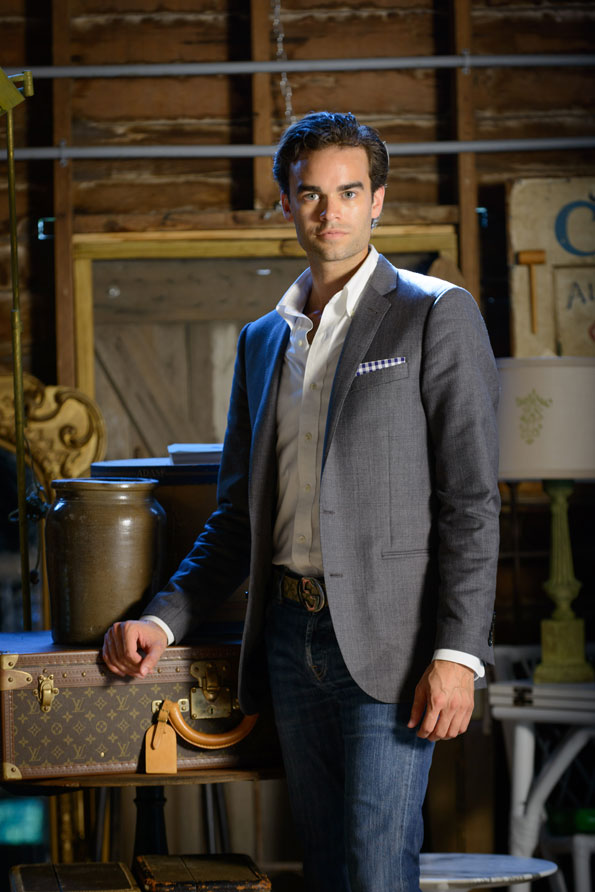Getting personal with one of Washington’s rising design talents.
By Anne Kim-Dannibale
Though Christopher Patrick‘s design firm is just a year old, the 27-year-old North Carolina-born Washingtonian has been designing ever since he can remember, starting with a habit of constantly rearranging his mother’s furniture as a youngster. His restless heart eventually led him to travel, which helped shape his aesthetic. After graduating from Marymount University with a bachelor’s degree in interior design, he honed his skills at various design-build firms before setting up his own shop with business partner Kaitlyn Andrews-Rice last year. Ever since, Patrick’s star has been rising, which was made only more noticeable with his redesign of a tiny bathroom in this year’s D.C. Design House. Most recently, he completed a project in the Cleveland Park neighborhood for a busy professional who frequently entertains.
Describe your style in three words.
Masculine, sophisticated, tailored
What design trend/element are you currently obsessed with and why?
Gray as the new beige. I love gray, and I love its versatility. You can use gray as a neutral backdrop for pops of color, to create a dynamic twist on traditional cabinet colors, or turn classic pieces of furniture into unexpected design statements.
A design secret you’re willing to share?
I don’t know if you’d consider this a secret, but one of my favorite things to offer my clients is wool drapery. Wool has such a wonderful hand and drape. It looks amazing as drapery, and takes on any shape and style you put it in.
What trends are here to stay (people should invest in them); Which are passing fads (not worth the money)?
I believe shagreen is one of those hot trends that’s here to stay. Because it’s a trend, it’s being offered in wild colors and tacky applications. If you want shagreen in your home, keep it simple and classic: natural colors and in small doses. Don’t go overboard.
I hope this isn’t a trend, but I’ve seen it on a major retailer’s website: deconstructed furniture. I saw an old telephone from the ’80s at a yard sale made of clear plastic with all its innards exposed. Apparently companies are now taking this concept and making furniture with exposed innards? I imagine in a few years I’ll see this deconstructed furniture on the side of the road as well.
Describe your typical client.
A married couple looking to update their home to better reflect their style. I’m usually the first designer they’ve ever worked with, and it’s a new experience to them.

The airy living room for a client in Cleveland Park, ideal for hosting large parties or more intimate gatherings. (Photo by Erik Kvalsvik. Architecture/contractor Wentworth, Inc.)
Briefly describe the Cleveland Park and D.C. Design House projects. What did the client ask for, and what were some of the key things that you did?
The Cleveland Park project was a newly purchased home. The client wanted to create an inviting space that would function for a bachelor lifestyle but also for entertaining. The client frequently entertains for business and pleasure. We transformed a large cavernous space into two more intimate seating areas that were equally perfect for hosting one guest as it is for hosting 20. A daybed became the nucleus of the space and allowed it to have this dual functionality.
The D.C. Design House was more conceptual. We were the client and the designer. The goal was to update the space while preserving its charm. The shower was completely redone with a tile detail, plumbing fixtures that embraced classic details in a new way, and an unexpected teak floor tray that garnered unexpected reactions (both positive and negative) from visitors. I also designed a custom vanity that added much-needed storage for the average person in the 21st century.

Patrick's vibrant, yet cozy bathroom in this year's D.C. Design House. (Photo by Stacy Zarin Goldberg)
How does the space as you designed it accomplish these goals?
In the Cleveland Park project the furniture really dictates the use of the room. It was the unusual furniture plan that allowed us to give the client a comfortable living room to hang in when he was by himself but also a sophisticated entertaining space for large parties.
We updated the D.C. Design House bathroom with new fixtures and a custom vanity, but by keeping the existing floor tiles and using classic materials like marble countertops and nickel fixtures, we were able to speak to the character of the 1950s home while bringing it into the 21st century. It had a classic appeal with a contemporary twist.






